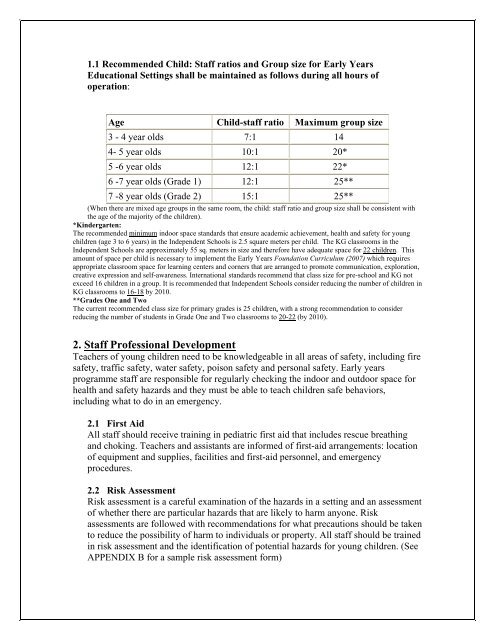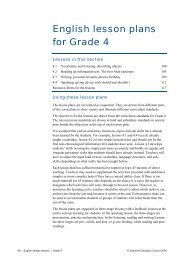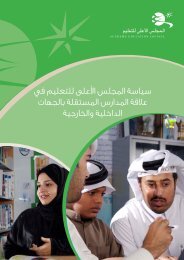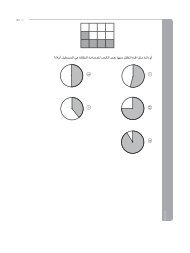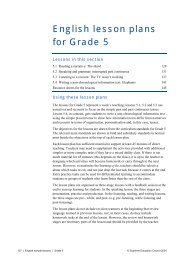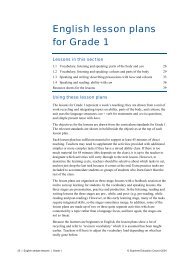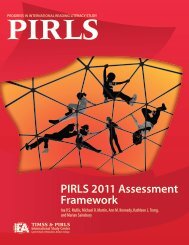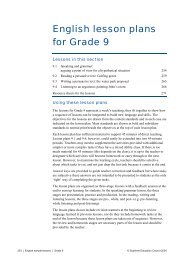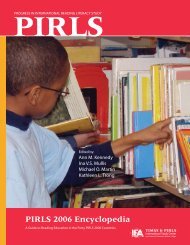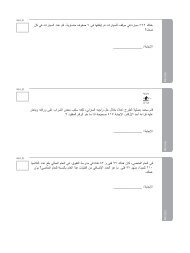Guidelines for Health and Safety Standards in Early Years ...
Guidelines for Health and Safety Standards in Early Years ...
Guidelines for Health and Safety Standards in Early Years ...
Create successful ePaper yourself
Turn your PDF publications into a flip-book with our unique Google optimized e-Paper software.
1.1 Recommended Child: Staff ratios <strong>and</strong> Group size <strong>for</strong> <strong>Early</strong> <strong>Years</strong><br />
Educational Sett<strong>in</strong>gs shall be ma<strong>in</strong>ta<strong>in</strong>ed as follows dur<strong>in</strong>g all hours of<br />
operation:<br />
Age Child-staff ratio Maximum group size<br />
3 - 4 year olds 7:1 14<br />
4- 5 year olds 10:1 20*<br />
5 -6 year olds 12:1 22*<br />
6 -7 year olds (Grade 1) 12:1 25**<br />
7 -8 year olds (Grade 2) 15:1 25**<br />
(When there are mixed age groups <strong>in</strong> the same room, the child: staff ratio <strong>and</strong> group size shall be consistent with<br />
the age of the majority of the children).<br />
*K<strong>in</strong>dergarten:<br />
The recommended m<strong>in</strong>imum <strong>in</strong>door space st<strong>and</strong>ards that ensure academic achievement, health <strong>and</strong> safety <strong>for</strong> young<br />
children (age 3 to 6 years) <strong>in</strong> the Independent Schools is 2.5 square meters per child. The KG classrooms <strong>in</strong> the<br />
Independent Schools are approximately 55 sq. meters <strong>in</strong> size <strong>and</strong> there<strong>for</strong>e have adequate space <strong>for</strong> 22 children. This<br />
amount of space per child is necessary to implement the <strong>Early</strong> <strong>Years</strong> Foundation Curriculum (2007) which requires<br />
appropriate classroom space <strong>for</strong> learn<strong>in</strong>g centers <strong>and</strong> corners that are arranged to promote communication, exploration,<br />
creative expression <strong>and</strong> self-awareness. International st<strong>and</strong>ards recommend that class size <strong>for</strong> pre-school <strong>and</strong> KG not<br />
exceed 16 children <strong>in</strong> a group. It is recommended that Independent Schools consider reduc<strong>in</strong>g the number of children <strong>in</strong><br />
KG classrooms to 16-18 by 2010.<br />
**Grades One <strong>and</strong> Two<br />
The current recommended class size <strong>for</strong> primary grades is 25 children, with a strong recommendation to consider<br />
reduc<strong>in</strong>g the number of students <strong>in</strong> Grade One <strong>and</strong> Two classrooms to 20-22 (by 2010).<br />
2. Staff Professional Development<br />
Teachers of young children need to be knowledgeable <strong>in</strong> all areas of safety, <strong>in</strong>clud<strong>in</strong>g fire<br />
safety, traffic safety, water safety, poison safety <strong>and</strong> personal safety. <strong>Early</strong> years<br />
programme staff are responsible <strong>for</strong> regularly check<strong>in</strong>g the <strong>in</strong>door <strong>and</strong> outdoor space <strong>for</strong><br />
health <strong>and</strong> safety hazards <strong>and</strong> they must be able to teach children safe behaviors,<br />
<strong>in</strong>clud<strong>in</strong>g what to do <strong>in</strong> an emergency.<br />
2.1 First Aid<br />
All staff should receive tra<strong>in</strong><strong>in</strong>g <strong>in</strong> pediatric first aid that <strong>in</strong>cludes rescue breath<strong>in</strong>g<br />
<strong>and</strong> chok<strong>in</strong>g. Teachers <strong>and</strong> assistants are <strong>in</strong><strong>for</strong>med of first-aid arrangements: location<br />
of equipment <strong>and</strong> supplies, facilities <strong>and</strong> first-aid personnel, <strong>and</strong> emergency<br />
procedures.<br />
2.2 Risk Assessment<br />
Risk assessment is a careful exam<strong>in</strong>ation of the hazards <strong>in</strong> a sett<strong>in</strong>g <strong>and</strong> an assessment<br />
of whether there are particular hazards that are likely to harm anyone. Risk<br />
assessments are followed with recommendations <strong>for</strong> what precautions should be taken<br />
to reduce the possibility of harm to <strong>in</strong>dividuals or property. All staff should be tra<strong>in</strong>ed<br />
<strong>in</strong> risk assessment <strong>and</strong> the identification of potential hazards <strong>for</strong> young children. (See<br />
APPENDIX B <strong>for</strong> a sample risk assessment <strong>for</strong>m)


